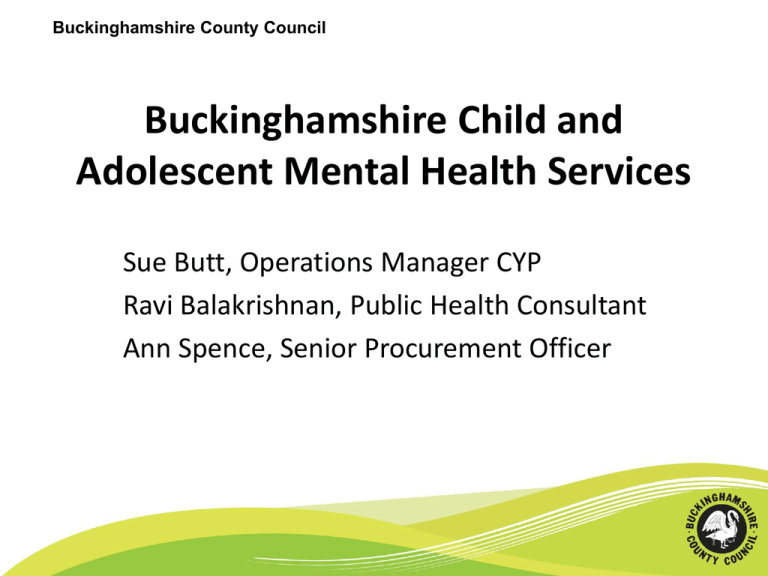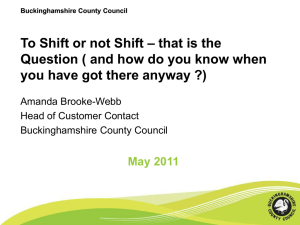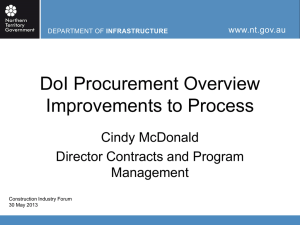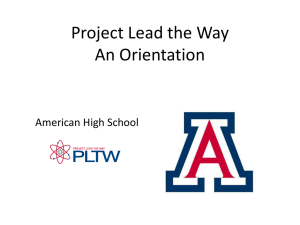
Buckinghamshire County Council
Buckinghamshire Child and
Adolescent Mental Health Services
Sue Butt, Operations Manager CYP
Ravi Balakrishnan, Public Health Consultant
Ann Spence, Senior Procurement Officer
Buckinghamshire County Council
Agenda
Welcome and Introduction - Sue Butt
Risks / Needs / Demands - Ravi Balakrishnan
Commissioning approach – Sue Butt
Procurement information – Ann Spence
Questions
Buckinghamshire County Council
Background
• Commissioned as an integrated service under
pooled budget S75 agreement in 2009
• Prior to this it was delivered by multiple providers
with multiple contracts across the county
• The recommissioning process will commence in
November 2014 with the plan to award the new
contract in April 2015
• New contract will commence in October 2015
Buckinghamshire County Council
Survey responses – May/June 2014
285 respondents
Buckinghamshire County Council
Current Services – areas of good practice
• Helpline was perceived as useful by those aware of it
• Positive experiences of treatment for many of those who
access it
• Some clinicians were cited as particularly helpful and
accommodating
Buckinghamshire County Council
Current Services – areas for development
• Communication – helpline, feedback on referrals, ease of
contact
• Collaborative/Partnership working across CAMHS, Social care,
GPs, Schools, Other health professionals, Families
• Clarity and consistency about thresholds and process for
access
• Waiting times for assessment and treatment
• Flexibility in service provision location and times
• Earlier intervention /prevention
Buckinghamshire County Council
Perceived gaps in provision
• Paediatric Psychology support for developmental
and physical health related issues
• Services for CYP who have a need for support but do
not meet criteria for mental health services
(threshold)
• Support post diagnosis for Families and young
people with a diagnosis of autistic spectrum.
• Perinatal mental health service
Buckinghamshire County Council
Children & Young People
Mental Health
Risks / Needs / Demands
in
Buckinghamshire: an overview
Dr Ravi Balakrishnan
Consultant in Public Health medicine
Bucks County Council
Buckinghamshire County Council
60-64
1.18%
1.25%
2.00%
3.01%
3.00%
55-59
3.00%
2.78%
2.76%
45-49
4.00%
3.50%
3.41%
40-44
4.08%
3.98%
35-39
5.45%
5.28%
30-34
5.78%
5.66%
6.41%
6.32%
6.75%
5.34%
15-19
6.58%
10-14
5.01%
5-9
5.98%
6.66%
5.00%
5.92%
5.89%
4.98%
4.85%
6.00%
6.02%
5.41%
7.00%
5.95%
5.54%
8.00%
6.00%
5.68%
Eng %
7.92%
7.30%
Bucks %
7.67%
7.15%
9.00%
7.04%
6.54%
Population makeup
1.00%
0.00%
<1
1-4
20-24
25-29
2011 census Total <19: 121,479
Boys <19: 62,125 (1 in 4 25.0%);
50-54
65-69
Girls <19:59,354 (23.1%)
70-74
75-79
80-84
85+
Buckinghamshire County Council
Ethnic Groups
Ethnic Group
White
Mixed
Indian
Pakistani
Bangladeshi
Chinese
Other Asian
Black African
Black Caribbean
Other Black
Other ethnic group
Boys
Girls
Total
%
80.5%
5.4%
2.4%
6.8%
0.3%
0.4%
1.7%
0.9%
0.8%
0.3%
%
80.1%
5.4%
2.5%
6.7%
0.2%
0.6%
1.7%
1.1%
0.8%
0.4%
%
80.3%
5.4%
2.4%
6.7%
0.3%
0.5%
1.7%
1.0%
0.8%
0.3%
0.5%
0.5%
0.5%
Data source: 2011 Census (NOMIS, table DC2101EW)
Buckinghamshire County Council
Child Poverty & Lone Parents
Children in Poverty
• One in ten (10.5%) children <16 years of age are living
in poverty (2011), England average:20.6% (2011)
Lone Parents
• 5.3% (2011) of households have lone parents with
dependent children (England ave:7.1%)
• 10,550 Lone parents with dependent children
(Data source: ONS 2011 census (NOMIS, table KS105EW)
Buckinghamshire County Council
Learning Difficulty
Emerson, E. et al, 2008
Estimated prevalence in C&YP with LD for different age groups as follows:
5 to 9 years: 0.97%; 10 to 14 years: 2.26%; and 15 to 19 years: 2.67%.
The Foundation for People with Learning Disabilities (2002): 40% prevalence for MH
problems associated with LD.
Age group
Ch CCG
AV CCG
Bucks
Children with a learning
disability
5-9 yrs
195
120
315
10-14 yrs
455
280
735
15-19 years
520
335
855
Learning disabilities with MH
problems
5-9 yrs
80
50
130
10-14 yrs
185
115
300
15-19 years
210
135
345
Total: LD with MH problems
475
300
775
Buckinghamshire County Council
Looked After Children
• In March 2013: 400 C&YP in care
• Rate: 34 per 10,000 vs national average 60 per 10,000 (43% lower)
• 2008-13: Increased by 30.8% (from 26 to 34/10,000) compared to 11.1%
rise (54 to 60 /10,000) nationally.
• Over 50% placed outside the county (England average of 35%)
• Strengths & Difficulties Questionnaire (SDQ):(Normal score range: 0-13).
• Average score: 12.93 Vs England average of 14.8 in 2012/13
• One in four (26%) had a score of 18 or above (SDQ),indicate significant
behavioural problems.
Buckinghamshire County Council
Substance misuse, Suicide, Self harm
BCC Survey 2013 (11-19 years)
Smoke: 4% smoke cig once a week; 1% reported smoking
shisha
RU Diff Survey (2013) year 9
Smoking: 7%;
Alcohol: 50% had a drink in last month;
42% felt the effects of alcohol atleast once in last month
Alcohol:
7% drink once a month;
3% drunk in the last week
Drugs: 17% have taken drug (Cannabis mainly)
30% Bullied at any time
Substance misuse (3 year period - 2010/11 to 12/13)
• 50 hospital admissions for substance misuse,
• Rate of 30.8 per 100,000 population aged 15-24
• 59% lower than the national average of 75.2
Self-harm (3 year period - 2010/11 to 12/13)
• 477 hospital admissions among young people aged 10-24 related to self-harm
• Rate of 179.8 per 100,000 populations
• 49% lower than the national average (352.3/100,000)
Buckinghamshire County Council
Prevalence of MH conditions
Pre-school children
Egger, H et al, 2006: Prevalence of any MH disorder: 19.6%
Among 2-5 year olds: AV CCG: 1,895
Ch CCG: 3,110
ASD
Area
ASD prevalence
rates based on
Baird et al (2006)
and by BaronCohen et al (2009)
All ASDs
9-10 years
AV CCG
285
465
Ch CCG
Bucks
ASDs
5-9 years
750
195
315
510
Buckinghamshire County Council
Prevalence of MH Problems
5-16 years of age (2012)
Prevalence varies by age and sex
Based on Green et al (2004)
ICD-10 Classification of Mental & Behavioural Disorders with strict impairment criteria
– the disorder causing distress to the child or having a considerable impact on the
child’s day to day life.
Area
Age
group
Ch CCG
5-10
AV CCG
Bucks
MH
Disorder
Conduct
disorders
Emotional
disorders
Hyperkinetic
disorders
Less
common
disorders
1,850
1,175
580
385
315
11-16
Total
5-10
2,735
4,855
1,570
1,190
335
335
1,110
710
350
235
190
11-16
Total
1,705
2,805
980
745
210
210
1,690
1,095
445
400
7,660
4,435
2,865
1,165
1,050
2,745
1,770
720
650
Buckinghamshire County Council
Prevalence of neurotic disorders
(aged 16 to 19)
Bucks
70
210
50
130
2,220
350
460
50
165
35
105
355
70
220
50
130
470
40
50
30
30
150
Any neurotic
disorder
125
85
85
55
Panic
disorder
400
960
265
595
Obsessive
compulsive
disorder
Depressive
episode
Boys
Girls
Boys
Girls
All phobias
Generalised
anxiety
disorder
AV CCG
Mixed
anxiety &
depressive
disorder
Ch CCG
Gender
Area
Bases on Singleton et al (2001) has estimated prevalence rates
670
1,485
450
920
3,525
Buckinghamshire County Council
Need for CAMHS services
(Estimated vs Actual)
Kurtz (1996)
Number of C&YP under 18 years who may experience MH problems appropriate
to a response from CAMHS at Tiers 1, 2, 3 & 4
Area
AV
CCG
Ch
CCG
Bucks
Tier 1
6,575
Tier 2
3,070
Tier 3
815
Tier 4
Bucks
35 Referrals
Accepted T2
10,710
5,000
1,325
55
Accepted T3
Signposted/
Inappropriate
17,285 8,070
2,140
90
2012/
2013
2013/ Change
2014
%
3,086
3,795
22.9
787
1,238
1,397
1,431
77.5
15
1,061
967
-8.8
Buckinghamshire County Council
In brief
•
•
•
•
•
•
•
•
•
•
C&YP <19: 121,479; Boys: 62,125 Girls:59,354
Ethnicity: 2 in 10 are non-white / others
1 in 10 under 16 children living in poverty
10,550 (5.3%) Lone parents with dependent children
LD with MH problems: Est 775
LAC: n= 400, increasing; 1 in 4 have SDQ 18 or more
Smoking: 4%-7%; Drugs: 17%
Hos Ad due to suicide & self-harm: < national average
Perinatal MH need: est 2,500
Prevalence of MH disorders:
Preschool: 5000; School Age:7,660
• Prevalence of neurotic Dis (16-19 yrs): 3,500
• Estimated CAMHS need Tier 2: 8,000 Tier 3: 2,000
• CAMHS use (Oxford H): Tier 2: 1,397 Tier 3: 1,431
Buckinghamshire County Council
For more information
• National Child and Maternal Health Intelligence network
http://www.chimat.org.uk/default.aspx
• Joint Strategic Needs Assessment
http://www.buckscc.gov.uk/community/knowing-bucks/joint-strategic-needsassessment/
Sources:
• General Practice (GP) registered patient counts aggregated up to CCG level
• Office for National Statistics mid year population estimates for 2012 (local authority report).
• The Foundation for People with Learning Disabilities (2002).
• http://www.chimat.org.uk/default.aspx
• Oxford Health Foundation Trust, 2014
• www.jcpmh.info
A model for integrated services
for children and young people
with mental health needs and
their families and carers
Lisa Smart
© MGA, 2014
Core principles
• Service must promote wellbeing
• Service must provide timely, effective
assessment, treatment and support
• Service must provide a seamless pathway
or journey through all levels of CAMHS
© MGA, 2014
Key requirements
• Single point of contact for referral and
assessment
• Key/link worker to stay with child, young
person and family throughout the
CAMHS journey
• Crisis support at home at weekends
• Flexibility for early evening / weekend
provision
© MGA, 2014
Key requirements
• Tier 2 service is expanded with specific
service outcomes monitored to ensure that
service pressures elsewhere do not encroach
on this core work
• Tier 3 service community based and able to
see children and young people in a variety of
settings
• Fluid transition between tiers to meet
changing need
© MGA, 2014
Key requirements
• ‘Bridge builder’ role to ensure a transparent
journey with adequate mapping and signposting
to appropriate complementary or alternative
service provision
• Cross CAMHS workers to develop service
provision to at risk and hard to reach groups
• All services to follow the improving
psychological therapies service transformation
agenda – accessibility, participation, measuring
outcomes, evidence based practice
© MGA, 2014
Children and young people’s good
mental health promoted, and
services delivered in partnership
Education
and Social
Care
services
© MGA, 2014
Provision of
high quality
materials to
inform parents
and the wider
workforce
about CAMHS
Participation
workers
Link workers
Adult mental
health liaison
Training on
identification
for the wider
workforce
Consultation
could lead to
assessment by
Tier 2 or Tier 3
practitioner
Consultation
could lead to
other service
provided by
other agency
Consultation –
with worker or
CYP and family
SINGLE POINT
OF ENTRY
Tier 3
assessment
&
formulation
Tier 2
Assessment
Link worker
Tier 4
Specialist
CRISIS
Weekend home based support
to CYP at risk,TIER
on the
3 cusp of tier
4
admission,
Core
function – treatment:
- working
in partnership
•
family
therapy with tier
3 •
interpersonal
TIER 3 therapy
•
CBT
Support
to Dialetical
•
play
therapy Behaviour
Therapy
group
work by out
of
Emergency
assessment
for self
• Intervention
hours
service
harm
Direct,D.B.T
brief,phone
evidence
based
TIER
2
-out
of hoursinterventions
paediatric
ward
Assessment
for
referral
Tier
therapeutic
with4C
TIER
2 to
• Consultation
based
assessments
Consultation
mini teams that
&YP
Consultation to Tier 1 workers,
can
be delivered
within
tier 3:
Delivering
evidence
based
supporting
to manage
CYP in Tier
• Prevention
•group
Looked
after
children’s with
work
in conjunction
1
appropriate.
• where
Consultation
•partner
Childagencies
Development Team
Consultation
appointments
• Intervention
• Autistic Spectrum Disorder
with CYP and parents,
• Transition to adult services
supporting into partner
agencies where appropriate
• Prevention
Supporting tier 1 staff in
initiatives to promote positive
mental health, universally
Supporting early identification of
MH needs by training universal/
tier 1 staff
Evaluation
Evaluation of child or
young person’s
progress against
personal goals and
decision regarding next
step
no further
intervention required
further
assessment indicated
further
intervention
*Tier 4
*Tier 3
*Tier 2
*Tier 1
Tier 3
Specialist
Pre-identification
Crisis Team
Tier 2
targeted
Identification
Tier 4
assessment
Intervention
Tier 1
Universal
Assessment
© MGA, 2014
Key changes in the
specification
• Single point of access for consultation AND
assessment
• Extension of Tier 2 role and related skills,
knowledge and experience requirements
• Link worker role to support child, young
person and family on their journey
• Fluidity between Tiers 2 and 3 with the
possibility of accessing interventions flexibly
across tiers
© MGA, 2014
Buckinghamshire County Council
Procurement Information
Ann Spence
Senior Procurement Officer
Finance & Commercial Services
10th October 2014
Buckinghamshire County Council
The Procurement Process
•
•
•
•
•
E-Procurement
Procurement Approach
Invitation to Tender (ITT)
Tender Timetable
Key points
Buckinghamshire County Council
e-Procurement
• The Council will be using the South East Business
(SEBP) Portal
(https://www.businessportal.southeastiep.gov.uk) to
publish and facilitate this procurement opportunity.
• Providers must be registered on the SEBP in order to
obtain details about and express an interest in this
opportunity.
• All documentation must be submitted electronically via
the SEBP.
Buckinghamshire County Council
Procurement Approach
•
The Council is seeking a single integrated contract in view of the
proposed service model and S75 pooled budget across
Buckinghamshire County Council, and Chiltern and Aylesbury Vale
CCGs.
•
The Council will accept bids from providers considering bidding as:
•
A Single Provider
•
A Lead Contractor, with Sub-Contracting Arrangements; or
•
A Consortia bid
Buckinghamshire County Council
Contracting Options
Lead Contractor, with Sub-Contracting Arrangements
•
A lead organisation may bid for the procurement opportunity.
•
The lead contractor will be responsible for the day to day management of
the contract and will be the organisation that holds the contract with the
Council.
•
The lead contractor may sub-contract various services to smaller, specialist
providers, to undertake work on their behalf.
•
Only the lead contractor is accountable to the Council.
•
The Council will be seeking to understand the sub-contracting
arrangements at the tender stage.
Consortia Bid
•
A number of providers become a single legal entity to enable them to bid
for procurement opportunities.
Buckinghamshire County Council
The Invitation to Tender (ITT)
• The ITT consists of:
•
•
•
•
•
•
•
•
•
A Set of Instructions
Evaluation Criteria
Specification
Terms & Conditions
Pricing Schedule
Method Statement
Confidentiality Agreement – TUPE
Organisational Information Questionnaire
Form of Tender
Buckinghamshire County Council
Invitation to Tender
•
•
•
•
•
•
ITT issued
Period for Q and A’s
Tender Return
Evaluation
Presentations
Award Decision
Buckinghamshire County Council
Timetable
•
•
•
•
•
•
Issue Tender
Tender Return
Presentations
Award Recommendation
Contract Award
Contract Start
mid to late Nov 2014
mid January 2015
early February 2015
early April 2015
mid April 2015
1st October 2015
Buckinghamshire County Council
Key Points
• Both parties should have one identified point of
contact
• All information is issued to all providers at the same
time
• Both parties should provide clear, easy to read
documents
• Provide double sided documents
• Cross reference any additional material you provide
• Keep to deadlines – we cannot accept late tenders
• Don’t presume we know what you do or can do –
Tell Us
Buckinghamshire County Council
Networking Opportunities
• In order to facilitate networking opportunities we are
asking providers whether they wish us to share their
contact details with all those who are interested.
• Email your contact details by 31st October 2014 to
camhsbucksconsult@buckscc.gov.uk
Buckinghamshire County Council
Any Questions?
Buckinghamshire County Council
Commissioners are seeking your views on:
• Contracting approach
• single integrated contract
• 5+2 year contract
• Financial Incentives – CQUIN is 1.5% - we would like to
place greater financial value on key performance
indicators.
• Commissioning model
Please email your thoughts to
camhsbucksconsult@buckscc.gov.uk by 19th October 2014









